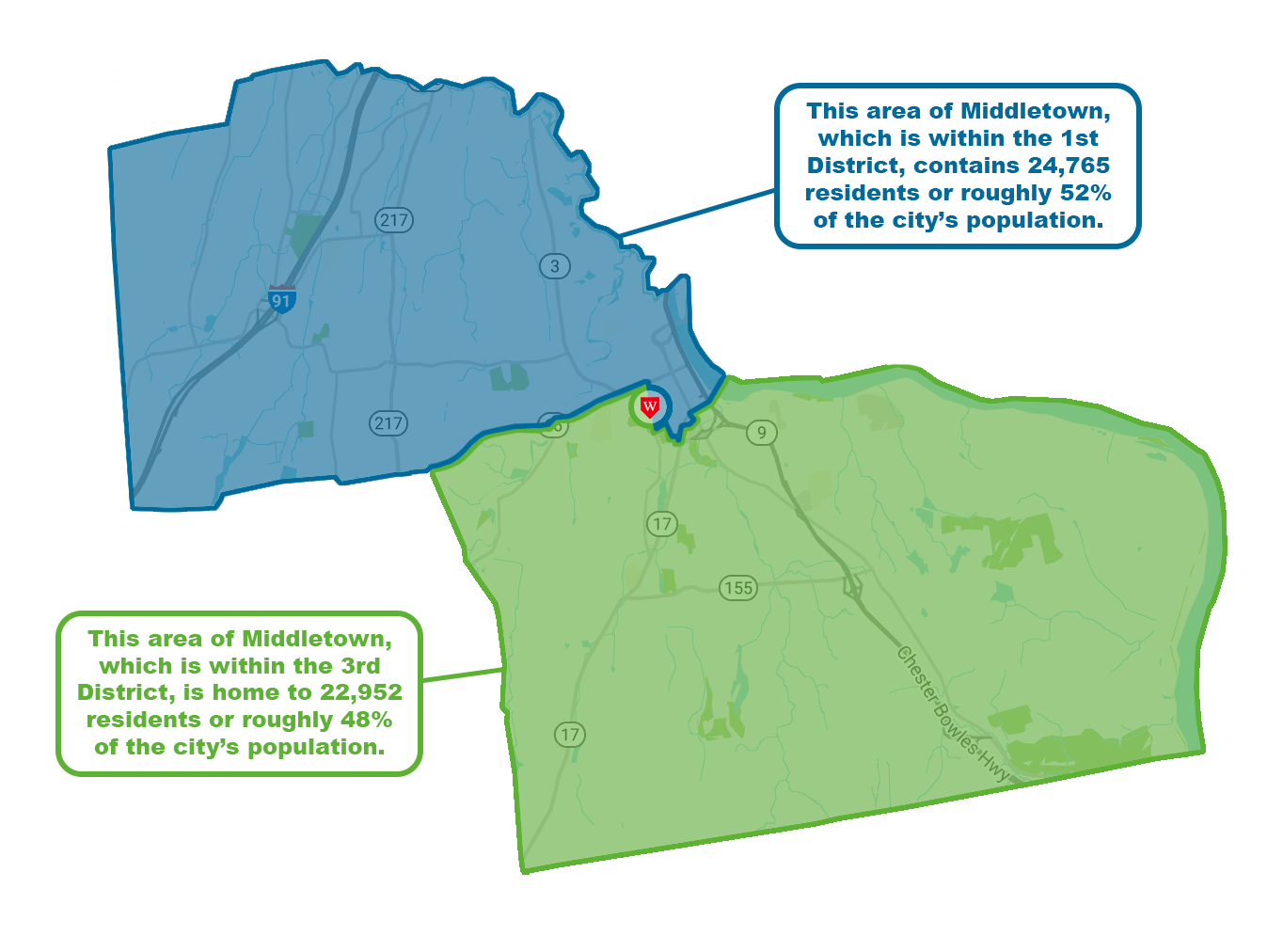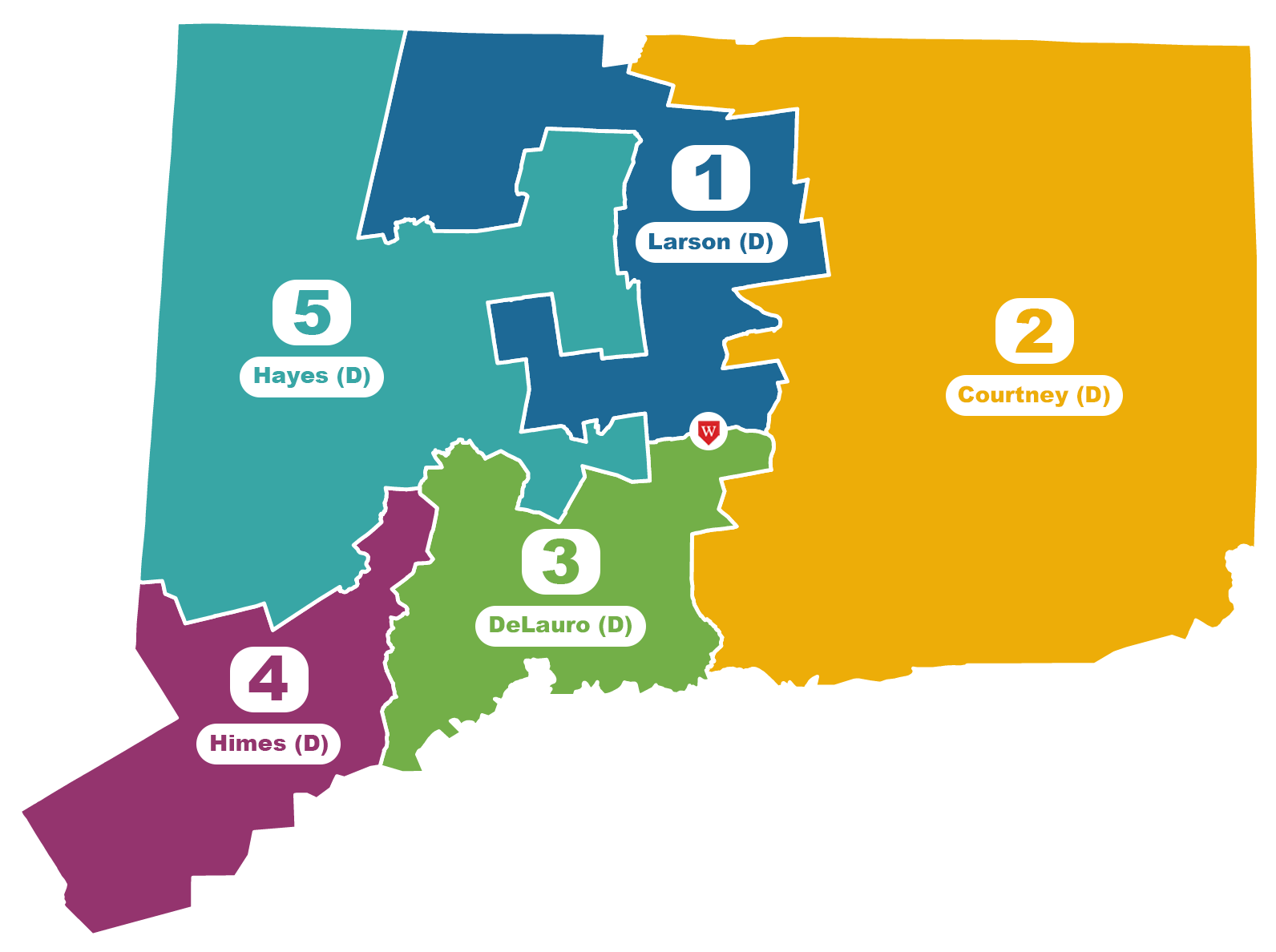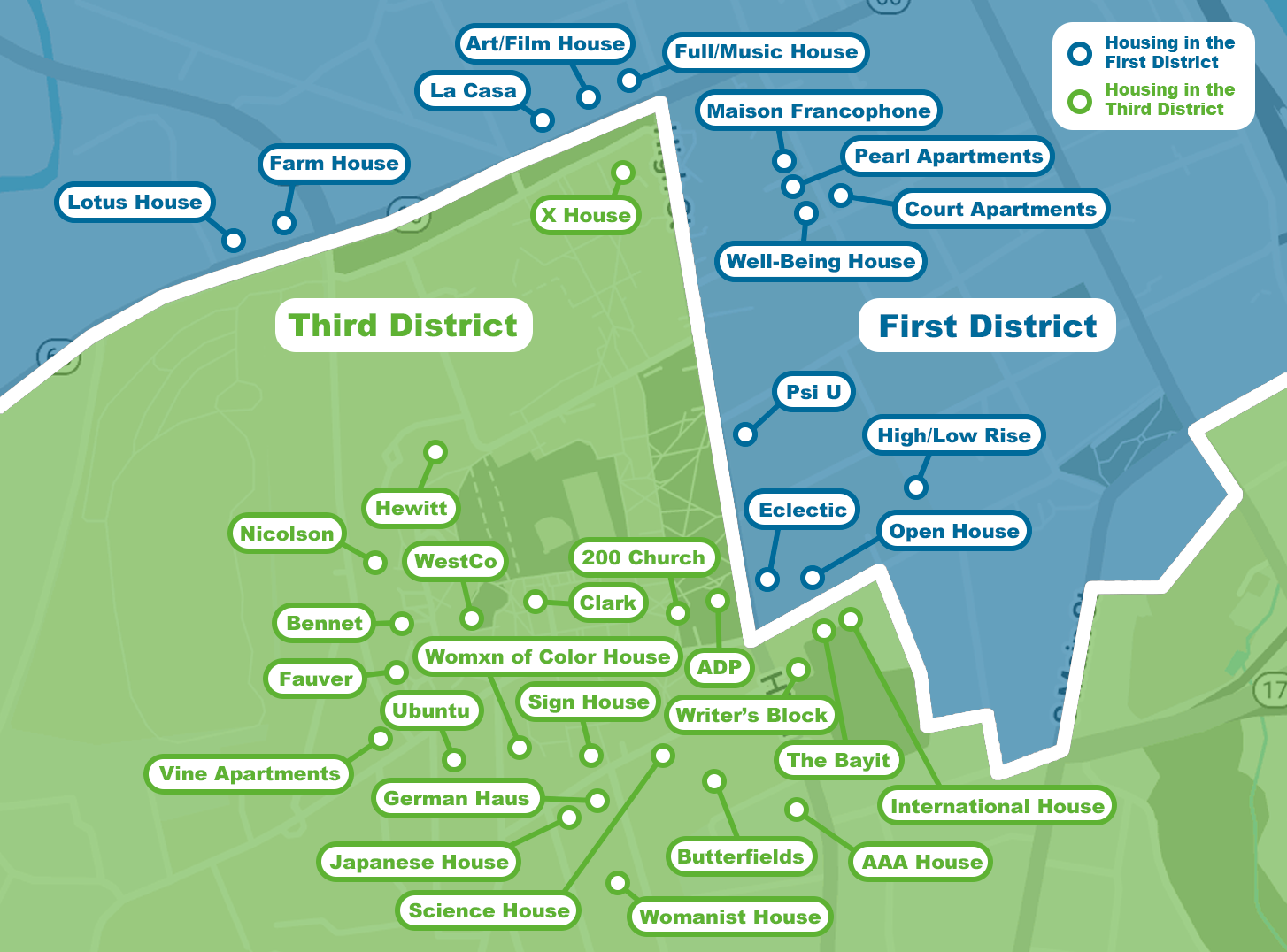Connecticut’s newly redrawn congressional districts, which were approved by the Connecticut State Supreme Court on Thursday, Feb. 10, divide the City of Middletown in two. The redistricting plan also splits Wesleyan, which was previously entirely within the third district, into different districts. The approved map was drawn by the court-appointed Special Master Nathaniel Persily after the Connecticut General Assembly (CGA) and Connecticut Reapportionment Commission missed their deadlines to determine the outline of the new congressional districts.

Every 10 years following the U.S. census, all states are required to redraw their congressional districts to more accurately and evenly represent their constituents. Unlike other states, whose seats fluctuated, Connecticut retained its five congressional districts. Consequently, the Connecticut state government would only have to alter the lines of pre-existing districts.
In fall 2021, the CGA drew, proposed, and passed new maps for State House and State Senate districts, but failed to meet their Wednesday, Sept. 15, 2021, deadline for the U.S. Congressional map. As per state law, the responsibility of redistricting was then passed to the Reapportionment Commission, which originally had a due date of Tuesday, Nov. 30, 2021, but requested and was granted an extension to Wednesday, Dec. 15, 2021 by the State Supreme Court. The Commission then missed this later deadline.
Subsequently, the State Supreme Court issued an order appointing Persily to the position of Special Master on Thursday, Dec. 23, 2021. Persily, who is the James B. McClatchy Professor of Law at Stanford Law School, served as the Connecticut Redistricting Special Master in the 2011 redistricting cycle. On Tuesday, Jan. 18, 2022, the court received Persily’s “Report and Plan of the Special Master,” which detailed his recommended redistricting plan. After a public hearing on Thursday, Jan. 27, the court adopted the recommended plan on Thursday, Feb. 10.
Many political institutions and analysts, including Cook Political Report, Inside Elections, and the University of Virginia’s Sabato’s Crystal Ball, expect Connecticut to retain its all-Democrat Congressional delegation, with almost every prediction denoting at least three of the districts as non-competitive. While on a statewide level, this congressional map might not mean a great deal of change, it could have more significant repercussions on the communities of Wesleyan and the City of Middletown.
Currently, the City of Middletown is almost entirely located within the third congressional district (Rep. Rosa DeLauro), with a small portion of northwestern Middletown—roughly 5,000 residents or 10% of the city’s population—located within the first congressional district (Rep. John Larson). However, under the new map, this is no longer the case.
Effective this fall, around half of the population of Middletown will be located in the first district while the other half will be in the third district, with Washington Street serving as the rough divider between the two.
For Chairman Mike Fallon of the Middletown Democratic Town Committee (DTC), this split was not a huge surprise, given Middletown’s geographic situation and Connecticut’s population shifts.
“Middletown can always be adjusted because of the fact that it’s a city right in the middle of the state,” Fallon said. “So we knew that there was going to be some changes that were going to be made, especially with population changes in some areas of the state…. The second congressional district, which is represented by Joe Courtney, lost population. So some of our members were wondering if [his district] would be in Middletown.”
Fallon, whose district shifted from the third to the first as a result of Persily’s plan, explained that he saw this newly drawn legislative map as an opportunity for Middletown to have more say in Connecticut’s congressional delegation.
“We currently, and will still, have two Congresspeople who represent Middletown,” Fallon said. “Congressman Larson does have a portion already, and the fact that [Representatives] have any portion means that they get involved and they help out Middletown…. So I’m not concerned. There are more people to reach out to, to advocate for Middletown, and that’s a good thing; we’re represented in more ways…. We’re a city, we have complex needs, we’re growing, and the more folks that can advocate for the City of Middletown, I think it’s for the better!”
In contrast, Chairman William Wilson of the Middletown Republican Town Committee (RTC) expressed his concern about the effects of this change on Middletown’s voting power.
“I’m unhappy about it because I feel that Middletown has no real say in either district,” Wilson said. “You’ve got Hartford in the first district, you’ve got New Haven in the third…. If we’re [entirely] in the first, we’re probably the second or third biggest town, and if we’re [entirely] in the third, we’re probably the third or fourth biggest town, so we have a little bit of say. But the way it is now, sadly, I don’t think we have much pull in either district.”
Wilson emphasized that the RTC would continue to place a great emphasis on campaigning for and appealing to state and local elected officials.
“I truly believe that our biggest say that we’ll have is with our state Senators and legislators,” Wilson said. “The 100th and the 33rd [State House districts] are in Middletown exclusively…. So I think we’ll probably work a little harder for the candidates that I feel that we can do more for…. I think people forget that you need the local representation and that local representatives are the ones that are gonna speak for you in Hartford.”

Fallon expressed similar sentiments about the DTC’s ongoing plan to focus on local elections.
“We always organize from the bottom up rather than the top down,” Fallon said. “There are many reasons that folks can go out to vote. They might be voting in November’s election because they want to vote for the next governor, they might want to vote because they’re really concerned about who controls Congress, but, ultimately, what we are putting most of our emphasis on as a Town Committee is focusing on the most local races…. So our strategy won’t change in that regard.”
Wilson explained that the RTC would also continue to put a great amount of organizational effort into spreading information to voters, especially those who are new to Middletown’s political scene. While, as the November 2021 elections showed, Democrats regularly outnumber Republicans in Middletown, Wilson sees a growing number of unaffiliated voters as a target demographic for the RTC.
“When someone new comes into town, it would be my goal to have a packet ready for them to know who’s their elected official, who’s downtown in the mayor’s office, and have all the information in one thing and give it to the person,” Wilson said. “The other thing is I think we’ll do more to [campaign] to some new people…. Before COVID we used to do coffee socials where we’d go to a diner or someplace nearby and just invite people to come have a coffee, talk to your elected officials, see what’s on your mind. It’s a way to get back to the people, and I think that’s an important thing to do as well.”
The congressional redraw will also have repercussions for the Wesleyan community, specifically for students who register to vote in Middletown from their on-campus residence, rather than their off-campus homes. While the entirety of Wesleyan’s campus was previously within the third district, roughly one in every seven housing assignments will fall in the first district under the newly drawn map.
Molly Meyer ’24, the President of the Wesleyan Chapter of Every Vote Counts (EVC)—a national organization that focuses on informing, registering, and mobilizing voters across the country from a non-partisan standpoint—explained that although most students assisted by EVC choose to vote in their home state, the shift will still affect students on campus.
“At Wesleyan, EVC helps a lot of students figure out how to request a mail-in ballot,” Meyer wrote in an email to The Argus. “Thus, most of the students we interact with are voting in their hometowns. That being said, we’ve been trying to interact more with the Middletown community, especially considering how low voter turnout is in Middletown for local elections.”
Meyer explained that the Wesleyan chapter focuses on spreading information and awareness about candidates and issues to the on-campus community in the weeks leading up to election day. Meyer expressed that while the change in districts may cause some confusion, the overall strategy of EVC is likely to remain the same.
“The confusion that will stem from this redistricting can be frustrating,” Meyer wrote. “Especially for local elections, people are less inclined to vote, and adding confusion about what district they’re in can turn someone away completely. Our strategy in the past has been to direct students and residents to the vote.org website where you can enter in your address and find your polling location. Our strategy for registering and informing voters shouldn’t change too much, but we may have to be a little more vocal to get people’s attention and offer clarity.”
Similarly, Co-Chair of the Wesleyan Democrats (WesDems) Matthew Lecher ’24 believes that the main consequence of the redistricting for Wesleyan students will be a lack of clarity surrounding who represents them.
“The thing that [the redistricting] is going to cause is the confusion factor for those that are registering on campus,” Lecher said. “Because Connecticut does have same-day voter registration, and when providing one’s address, they don’t know if it’s going to go to a PO box, they don’t know if it’s going to go to their program house, they don’t know if it’s going to go to any other address where they mail their packages to, et cetera, et cetera.”

Lecher, however, remains optimistic that this new split would provide voters on campus an opportunity to make their voices more widely heard.
“What I found most interesting is the mobilization strategy aspect,” Lecher said. “When it gets time for [the] 2022 [elections], I think that we’re going to need to get as many people registered in every district as possible, and I think that with Wesleyan…being spliced between two congressional districts, we can effectively rally our members at WesDems and politically active folk on Wesleyan’s campus to lend their support to two congressional districts rather than one.”
From a broader political perspective, Lecher expressed confidence in Democratic victories in the first and third districts.
“I am very hard-pressed to find out whether [the first and third] districts will flip red or not,” Lecher said. “I don’t believe they will, and that’s sort of very contingent on the fact that Connecticut’s congressional map is still going to have five blue representatives at the end of the day, even in a massive red year, like 2010.”
As it stands, the nationwide redistricting cycle of the past year has seen several lawsuits and complaints surrounding political or racial gerrymandering. Most recently, controversy has spread over Alabama’s new map, which was temporarily reinstated by the Supreme Court after being struck down by a federal district court in Birmingham for disenfranchising Black voters. Depending on when the Supreme Court hears the case, the map will remain in place at least through the 2022 election cycle and possibly longer.
Ohio also saw its congressional map proposal shut down. After implementing a new redistricting process this year, its plan was blocked by the Ohio State Supreme Court for unfairly advantaging the Republican Party. However, the state has since passed another similar map that has not yet been challenged by the State Supreme Court.
Many other states, making up roughly two-fifths of the House of Representatives, have maps that are currently facing litigation for alleged bias benefiting one party or alleged racial gerrymandering, notably including Georgia, New York, Pennsylvania, and Texas.
In light of Connecticut’s redistricting cycle and the nationwide process, Wilson emphasized the value of bipartisanship and neutrality when creating congressional maps.
“I think that if they’re going to do this redistricting…every 10 years, I think that they have to have both sides sit at the table with an arbitrator,” Wilson said. “I think with an arbitrator, someone who’s considered a neutral individual, and the two parties sitting down and discussing is probably the best way of dealing with an issue like this.”
Speaking about the imbalance of the reapportionment and redistricting processes, Lecher called for a bipartisan understanding that major voting blocs, cities, and communities should not be divided by congressional maps. In addition, he explained how votes can be diluted in several ways.
“There is true voter suppression in a lot of Southern states in this country to make it harder for people to register to vote and, thus making it also harder for people to cast their card in the census,” Lecher said. “At the same time, there is an issue ongoing with racial gerrymandering in this country. I don’t think it’s solely in the Northeast, I don’t think it’s solely political, and I don’t think it’s solely in the South.”
Meyer also pointed out that voters can have their voices diminished in more subtle ways.
“Most people are familiar with the obvious forms of voter suppression, but small things like long lines and relocating polling locations are forms of voter suppression as well,” Meyer wrote. “Depending on how Middletown intends to inform residents about the redistricting, the result of these changes have the potential to lower voter turnout.”
Fallon articulated that getting out and voting was crucial to making voices heard, especially during non-presidential elections. Though many ignore or forget about these off-year contests due to lower media coverage, he emphasized their importance in the grand scheme of politics.
“Everything from control of the state Senate, to who is governor, to who controls Congress can hinge on midterm elections,” Fallon said. “So I just encourage that everyone votes in the midterms because they are crucial as well.”
Lecher highlighted the importance of student participation in Wesleyan’s culture of activism.
“Wesleyan does have a culture of activism, whether it’s political or apolitical, it’s still activism,” Lecher said. “I have seen this campus sort of become a little bit less political during my time here, but at least people are passionate around issues…. So whether it’s political or not, it still has that culture of involvement.”
Students living in High Rise, Low Rise, Pearl Street apartments, Court Street apartments, Eclectic/Movement House, Psi Upsilon, Open House, Well-Being House, Maison Francophone, Full/Music House, Art/Film House, La Casa de Albizu Campos, Farm House, Lotus House, or any wood-frames or other residences within the blue section of the map will be located within the first district for the November elections.
Students living in any residence hall, Fauver apartments, Vine Street apartments, Alpha Delta Phi, the Bayit, International House, Malcolm X House, Womxn of Color House, Sign House, Ubuntu, German Haus, Japanese House, Womanist House, Asian/Asian-American House, Science House, or any wood-frames or other residences within the green section of the map will be located within the third district for the November elections.
Community Engagement House, Light House, Russian House, and Earth House have not been included as they are slated to be moved due to Life Science Center construction.
Sam Hilton can be reached at shilton@wesleyan.edu.



Leave a Reply